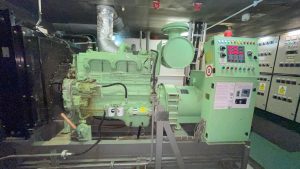Emergency generators are crucial to a ship’s electrical system, providing backup power during main generator failures. This article aims to educate ship cadets, seafarers, and maritime professionals about the operation, maintenance, and importance of emergency generators onboard vessels. Emergency generators are indispensable for ensuring the safety and operational integrity of ships. Understanding their functions, operational mechanisms, and maintenance protocols is crucial for maritime professionals. Regular training and adherence to regulatory standards will enhance preparedness for emergencies at sea, ultimately safeguarding lives and property.By fostering a thorough understanding of emergency generators among cadets and seafarers, the maritime industry can ensure that its professionals are equipped with the knowledge required to handle critical situations effectively.
Purpose of Emergency Generators
Emergency generators serve several vital functions: They automatically activate when the main power supply fails, ensuring that essential systems remain operational. This includes navigation, communication, lighting, and machinery necessary for safe operation. By powering critical systems such as steering and propulsion, emergency generators help maintain control of the ship during emergencies. They also support fire-fighting systems and emergency lighting, which are crucial for crew and passenger safety
These generators allow for the continued operation of ballast pumps and refrigeration systems, which are essential for maintaining the ship’s stability and preserving perishable goods
Technical Specifications, and Operation of Emergency Generators
Emergency generators vary in size and capacity depending on the vessel type. Smaller vessels may require only a few kilowatts for basic lighting, while larger ships like LPG carriers may need hundreds of kilowatts to support more complex systems. They are typically located in compartments above the waterline to prevent flooding and are connected to an emergency switchboard
The operation of emergency generators involves several key processes:
- Automatic Start-Up: When a power failure is detected, an electrical relay triggers the generator’s start-up sequence within 45 seconds. This quick response is critical for maintaining essential services
- Starting Mechanisms: Emergency generators can be started using various methods, including battery start and manual hydraulic or pneumatic systems. At least two starting modes should be available to ensure reliability
Regular testing is essential to ensure functionality. Weekly checks typically involve running the generator unloaded to verify that it starts correctly. Monthly tests should simulate power loss to confirm automatic operation
Maintenance Requirements
Proper maintenance of emergency generators is vital for ensuring their reliability and readiness in critical situations. Regular inspections and operational tests are essential practices that help identify potential issues before they escalate into significant failures. During these routine checks, crew members should meticulously examine the auto-start equipment to confirm that it functions correctly. Additionally, conducting load tests when feasible is crucial to ensure that the generator can handle the necessary electrical load during an emergency.
Regulatory Standards
Emergency generators are subject to strict regulations to ensure their reliability and effectiveness during emergencies. The key regulatory framework governing emergency power systems on ships includes the International Convention for the Safety of Life at Sea (SOLAS) and the International Safety Management (ISM) Code. This section expands on these critical points, providing a comprehensive understanding of the regulatory requirements.
– SOLAS Regulations
The SOLAS convention outlines specific requirements for emergency generators in Chapter II-1, which focuses on the construction and equipment of ships. Key regulations include:
- Regulation II-1/43: This regulation mandates that every passenger and cargo ship must be equipped with an emergency source of electrical power capable of supplying essential services during emergencies. The emergency generator must be able to provide power for at least 18 hours for cargo ships and 36 hours for passenger ships
- Location Requirements: Emergency generators and their associated switchboards must be located above the uppermost continuous deck, away from machinery spaces, and behind the collision bulkhead. This positioning minimizes the risk of damage during incidents that could affect the main power supply
- Operational Capability: The emergency generator must be capable of operating with a list of up to 22.5° and a trim of up to 10°. This ensures that the generator remains functional even in adverse conditions
- Starting Mechanism: Emergency generators should start automatically within 45 seconds after a power failure is detected. They must be designed to start at ambient temperatures down to 0°C, with heating arrangements required if lower temperatures are expected
- Fuel Specifications: The fuel used for emergency generators must have a flashpoint of not less than 43°C, ensuring safety during operation
- Starting Energy Requirements: The emergency generator must have sufficient stored energy to allow for at least three consecutive starts using a primary starting system (usually battery-powered) and an additional three starts within 30 minutes using a secondary system (such as pneumatic or hydraulic).
– International Safety Management (ISM) Code
The ISM Code complements SOLAS by establishing safety management objectives for shipping companies. It emphasizes the importance of safety management systems (SMS) that include provisions for emergency power systems. The ISM Code requires ship operators to develop a Safety Management System that includes procedures for maintaining and testing emergency generators. This ensures that all crew members are trained in emergency procedures and familiar with the operation of emergency power systems. Operators must maintain records of all tests, inspections, and maintenance activities related to emergency generators. This documentation is essential for demonstrating compliance with SOLAS and ISM requirements during audits and inspections. Regular drills and training should be conducted to ensure that crew members can effectively respond to power failures and utilize emergency generators as needed. The ISM Code mandates that all personnel receive training relevant to their duties concerning safety management practices.


